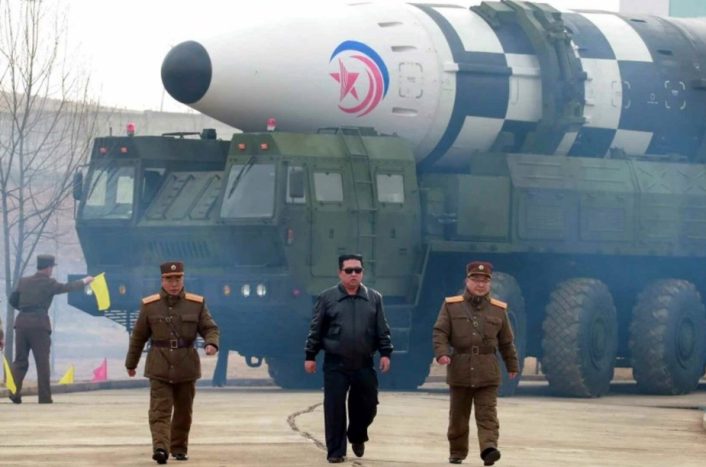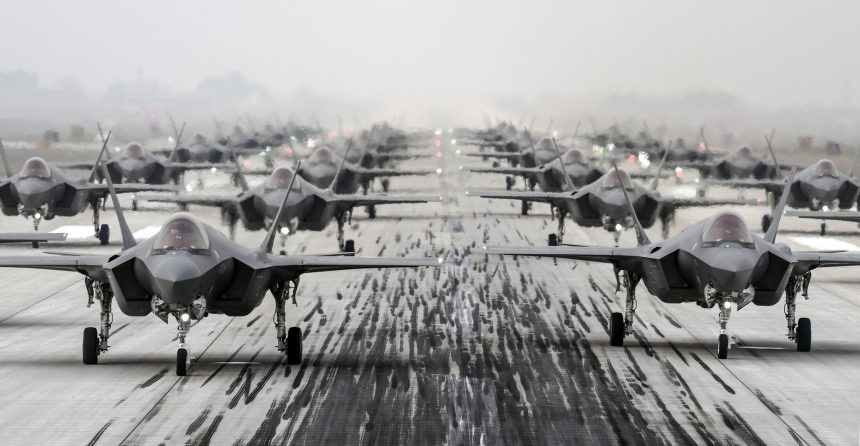The Republic Of Korea Air Force (ROKAF) has carried out training activities that included an “Elephant Walk” with 28 F-35s on the day after North Korea test-launched a “monster” Intercontinental Ballistic Missile (ICBM).
On Mar. 24, 2022, Democratic People’s Republic of Korea (DPRK) strategic forces test-launched the new Hwasongpho-17 intercontinental ballistic missile “under the direct guidance” of its leader Kim Jong Un. The launch was carried out at the Pyongyang International Airport, North Korea’s main international airport, according to state media. The ICBM was test fired vertically, from a TEL (Transporter Erector Launcher) and flew 1,090 kilometres for 4,052 seconds reaching the highest altitude of 6,248.5 kilometres before “correctly hitting the target in the set waters over the East Sea of Korea”.
Dubbed a “monster” missile for its size, the new ICBM was originally unveiled during the Korean Workers Party parade on Oct. 10, 2020. The ballistic missile, believed to carry multiple warheads and have a range exceeding 13,000 km, had already been used for two tests, on Feb. 27 and Mar. 5, 2022, that did not demonstrate ICBM range but were likely useful to evaluate this new system before conducting a test at full range in the future, potentially disguised as a space launch. The one on Mar. 24 is believed to be the fourth launch for the Hwasongpho-17 as the missile is presumed to have failed on test carried out on Mar. 16, 2022.
This is actually 🇰🇵 Hwasong-17 ICBM suspected 4th flight following two partial tests under the ‘reconnaissance satellite’ guise and a failure
27 Feb 2022
300km▶️620km🔼
05 Mar 2022
270km▶️560km🔼
16 Mar 2022❌
nk▶️20km🔼
22 Mar 2022
1100km▶️6000km+🔼https://t.co/eVnDmce3sT
— Joseph Dempsey (@JosephHDempsey) March 24, 2022
“The test-launch clearly proved that all the parameters of the weapon system exactly met the design requirements and that its prompt operation can be guaranteed scientifically, technically and practically under wartime environment and conditions,” said the state-controlled KCNA.
“The new type weapon system to be operated by the strategic forces of the DPRK under a plan for building up the state nuclear force will creditably perform its mission and duty as a powerful nuclear war deterrent of putting under strict control the nuclear war threats and challenges against the DPRK, taking the initiative to cope with any military crisis and defending the security of the country.”
“Kim Jong Un remarked with pride that the emergence of the new strategic weapon of the DPRK would make the whole world clearly aware of the power of our strategic armed forces once again, adding that the event would be an occasion of convincing the world of the modern feature of our strategic forces and further consolidating the foundation of guarantee and confidence in security of the state based on it. He stressed that the successful development of the new type ICBM, a complex of ultra-modern defence science and technology, is a striking manifestation of the might of our independent defence industry that started and developed by our own strength.”

According to the South Korean media, the Joint Chiefs of Staff (JCS) detected the launch, at a lofted angle, from the Sunan airfield in Pyongyang at 14:34 LT and the missile flew some 1,080 kilometers at a top altitude of over 6,200 km, confirming what North Korea’s claims. The latest launch came four days after North Korea fired four artillery shots into the Yellow Sea, apparently using multiple rocket launchers, from Sukchon, north of Pyongyang.
In response to North Korea’s eastward bound launch the Japanese Ministry of Defense launched a P-3C maritime patrol aircraft and at least one F-15J fighter. A video, shot from the cockpit of the JASDF (Japan Air Self-Defense Force) F-15J shows the ICBM during the ascent phase.
北朝鮮が、本日午後、朝鮮半島西岸付近から1発の弾道ミサイルを東方向に発射したことを受け、防衛省・自衛隊は、P-3C及びF-15を発進させ、青森県沖において被害情報の収集を行いました。その際、F-15は、今般発射された弾道ミサイルに関連していると推定されるものを空中で確認しました。 pic.twitter.com/m8Ukr4nYf4
— 防衛省・自衛隊 (@ModJapan_jp) March 24, 2022
In January, Pyongyang had already made a veiled threat that it could lift its voluntary moratorium on strategic weapons tests declared in April 2018 amid nuclear diplomacy with Seoul and Washington. The latest test of this “moster” weapon is a clear message to the U.S. and rest of the world about Pyongyang’s growing nuclear deterrence capabilities. “Respected Comrade Kim Jong -un affirmed that the strategic armed forces of the Democratic People’s Republic of Korea are fully prepared to thoroughly block and deter any dangerous military intentions of the American imperialists,” says the official statement released after the test.
Anyway, as a consequence of the North Korea’s show of force, the South has also flexed its muscles, putting its most advanced aircraft, the F-35A in parade. An Elephant Walk that included 28 out of 40 F-35A the ROKAF has received was widely advertised across the social networks with the slogan “Invisible power to protect South Korea” to show that the South Korea’s military “will use the F-35A with all-weather stealth and precision strike capabilities to achieve overwhelming strategic victories and maintain a full military posture that will deter further North Korea’s actions”.
South Korea conducted a rare training involving its F-35A in a show of airpower on Mar. 25, a day after North Korea test-fired an ICBM. This marked the first major mobilization of the stealth fighters after South Korea Air Force completed the deployment of 40 F-35A in January. pic.twitter.com/MCW1rot9J8
— Ryan Chan 陳家翹 (@ryankakiuchan) March 25, 2022
The ROKAF F-35 fleet is based at Cheongju AB, southeast of Seoul, in the center part of South Korea, home of ROKAF’s 17th Fighter Wing and its two child units, the 151 Fighter Squadron and 152 Fighter Squadron, that operate the 5th generation jet. The Republic of Korea selected the F-35 at the end of its F-X III fighter acquisition program with the signing of a Letter of Offer and Acceptance (LOA) between the U.S. and Korean governments on Sept. 30, 2014. In total, South Korea ordered 40 F-35A. In December 2017, South Korea’s Defence Acquisition Program Administration established a process for procuring the 20 additional aircraft, the Joongang Ilbo newspaper reported, citing multiple government sources. The first F-35A for the ROKAF, known as aircraft AW-1, took flight in Fort Worth, Texas, in March 2018. In the same year, the first F-35A was delivered to Luke AFB, Arizona, for pilot training while in 2019, the first F-35As were delivered to their permanent base in South Korea.
Following a belly landing incident, the fleet was temporarily grounded in January 2022.









